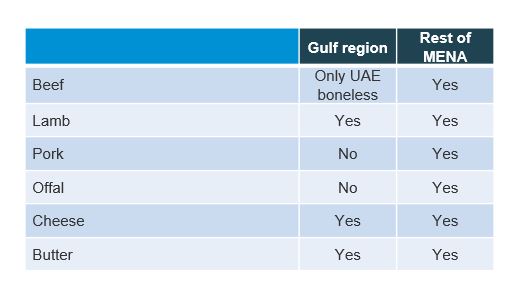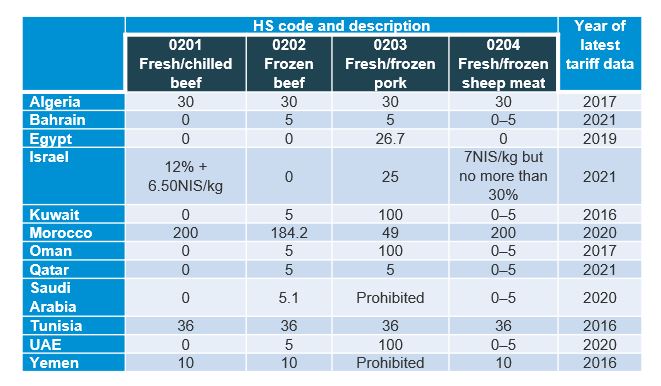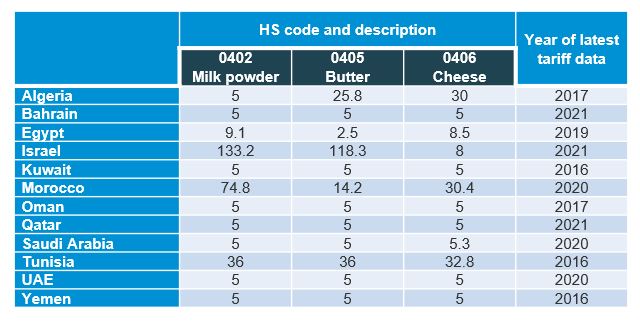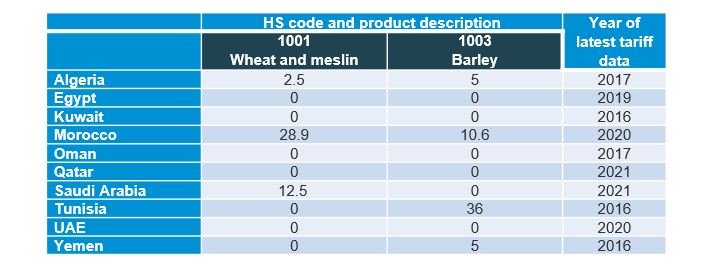- Home
- Middle East and North Africa (MENA): Market access and barriers to trade
Middle East and North Africa (MENA): Market access and barriers to trade
When it comes to trade, it is essential to understand the conditions and criteria that affect the flow of animal and crop commodities.
Table 1 shows whether or not the UK has an export health certificate in place to export meat and dairy products to MENA countries. Table 2 displays the average import tariff applied on red meat in selected MENA countries.
Table 1. Export health certificates (Gulf region and rest of MENA)
Table 2. Average import tariffs for red meat in selected MENA countries (%)
Averaged tariff rates are expressed as % of price, except where stated
Source: World Trade Organisation and UK government
Beef and lamb
Halal Export Certificates and Export Health Certificates are required for livestock exports in the region. The UK has only secured these for lamb in the Gulf region. The Gulf region is the second largest export market for UK lamb producers. However, UK product has a relatively low shelf life compared to the main competitors (New Zealand and Australia).
Tariffs vary widely across the region. The main markets in the Gulf region are relatively low (at 5% for frozen and zero for fresh beef and lamb), whereas they are relatively high in Morocco (200% for frozen product).
The key opportunities for beef and lamb are in UEA, Saudi Arabia, Bahrain, Kuwait, Oman, Qatar and Jordan, due to a combination of relatively low tariffs and high demand.
However, tariffs are not the main trade barrier in this growing market: it is the halal certification requirements, particularly for beef. In addition, the UK lacks beef Export Health Certificates (EHCs), in the Gulf region due to its historical disease status.
Pork
Opportunities for pork are limited due to low consumption in the region, as well as a lack of EHCs and relatively high tariffs.
Dairy
Tariffs for dairy vary (Table 3) from 75% for milk and cream in Morocco to 5% for powders, cheese and butter in the Gulf region.
The key opportunities for dairy are in UAE, Saudi Arabia, Bahrain, Kuwait, Oman and Qatar, where tariffs are relatively low and demand is high and growing.
Table 3. Average import tariffs for dairy products in selected MENA countries (%)
Averaged tariff rates are expressed as % of price
Source: World Trade Organisation
Cereals
There are no import tariffs on wheat and barley in most of the MENA countries listed in Table 4.
Although Morocco has the highest import tariff on wheat and an import tariff on barley, the UK has an agreement that allows imports for these cereals from the UK to enter Morocco tariff free. The exception is soft wheat for use as feed, which has a preferential tariff of 2.5%.
Table 4. Average import tariffs for wheat and barley in selected MENA countries (%)
Averaged tariff rates are expressed as % of price
Source: World Trade Organisation
In general, tariff rates for wheat and barley do not prohibit trade. However, non-tariff barriers, such as specific moisture requirements, pose a greater challenge.
For example, Egypt imposes no tariffs on wheat imports. However, it requires milling wheat with a maximum moisture content of 13%. Typically, the moisture content of UK milling wheat is higher than this. It would take considerable investment in drying facilities at UK ports to obtain the required moisture content for exports.
The UK does export wheat and barley to the MENA region at a maximum moisture content of 14%, which Morocco, Algeria, Tunisia and Libya accept.





